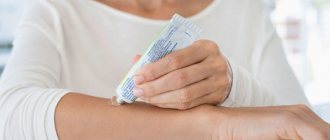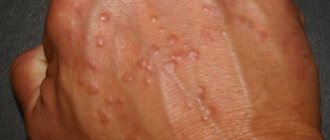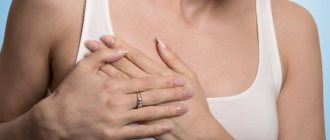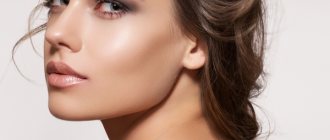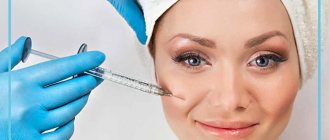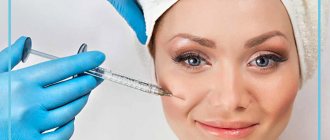Acne* on the back: causes
The main causes of acne on the back include the following [4, 29, 50]:
- Insufficient hygiene. During bathing, not much attention is paid to the back area, although this is one of the seborrheic areas where a large number of sebaceous glands are located.
- Choosing the wrong clothes. Due to wearing synthetic clothing, the skin does not breathe, sweating increases, which can lead to rashes and creates favorable conditions for the growth of bacteria.
- Using the wrong skin care products. Some cosmetics have a comedogenic effect, that is, they clog pores.
- Hormonal imbalance. Often pimples* and acne on the back occur due to the active production of hormones. This often happens to women during menstruation, pregnancy, menopause and adolescents during puberty.
- Stress. Frequent stress and emotional overstrain cause the body to produce large amounts of cortisol and adrenaline, which affect the functioning of the sebaceous glands.
- Taking certain medications. Long-term use of steroids, hormones, and antidepressants can negatively affect the condition of the skin.
Heredity, poor nutrition, prolonged mechanical stress and internal causes, for example, diseases of certain organs and systems also provoke the development of acne. [4, 29, 50]
Why acne appears: hormones are to blame
Acne is a consequence of excessive activity of the sebaceous glands. There is so much sebum that the skin simply cannot cope with its removal; as a result, the sebaceous glands become clogged and become inflamed. Sebum becomes clogged in enlarged pores and becomes black when oxidized. This activity of the sebaceous glands is due to hormonal levels. The reason is increased testosterone levels. And it happens not only during adolescence, but also in adulthood.
Elevated levels of free testosterone may be an individual feature or a consequence of pathology. In women, severe acne can often be a symptom of polycystic ovary syndrome.
In any case, if you have acne, you should get tested for sex hormones and a biochemical blood test. Women definitely need to undergo an ultrasound of the pelvic organs with a targeted study of the ovaries.
Hyperandrogenism can be caused by:
- hereditary factors;
- pathologies of the thyroid gland;
- hyperfunction of the adrenal glands and other reasons.
Acne* on the back: which organ may not be working properly?
There is a myth that the location of acne is related to the functioning of a particular organ. Here are the organs that acne* on the back is supposedly responsible for [208]:
- liver (hepatitis);
- organs of the gastrointestinal tract;
- genitourinary system;
- endocrine system.
In fact, it is impossible to determine which organ hurts based on acne* on the back, because this hypothesis has no scientific evidence. Therefore, when treating rashes, specialists do not rely on this theory.
Genetics
Many skin diseases, such as psoriasis and atopic dermatitis, are genetically determined. Doctors have long noticed that there is a hereditary predisposition to the development of acne. Even during puberty, those children whose parents had similar problems suffer from acne more often. Scientists have found that several genes, including HLA-DRA, are responsible for the development of severe forms of acne.
In this case, the level of testosterone in the blood may be within normal limits, but the skin receptors are too sensitive to androgens, and this feature is due to genetics.
How to treat acne* on the back?
Treatment is prescribed by a specialist, based on the clinical picture and severity of acne. For mild acne, the emphasis is on external therapy and the use of topical medications. For moderate acne, combination treatment is necessary; for severe acne, systemic medications are mainly used. [18]
It is also recommended to adhere to the following rules:
- To cleanse the skin, use products without preservatives, oils, or fragrances;
- during periods of acne remission, scrub or use peelings for exfoliation;
- after playing sports or strenuous physical activity, be sure to take a shower immediately;
- wear comfortable clothes made of breathable materials;
- change bed linen and towels every week.
Acne treatment should be regular. You should not interrupt or abandon it, as this may reduce the effectiveness of therapy.
Severity of acne and duration of treatment in adolescents
Acne on a teenager's face can look different - small red rashes, pustules, blockages, blackheads, painful nodes. Acne on the back of a teenager is one of the signs of the severity of acne. And the remedy for acne (for teenagers) is selected depending on this degree of severity of the process. The duration of treatment depends on how severe the acne is and whether the doctor’s prescriptions are strictly followed.
Treatment may take 3 months, or maybe a year. Typically, teenagers are not burdened with multi-level home care and procedures, but it is still necessary to do the minimum for results. In any case, already in the first or second month the skin becomes clearer, this is very encouraging for both parents and children.
And at the same time relaxing. It is important not to interrupt this path halfway, as everything will quickly return to its roots, and perhaps twice as much effort will be required the second time.
Drawing conclusions
Adult acne can occur for the following reasons:
- hormonal imbalance, hyperandrogenism;
- heredity;
- diseases of the thyroid gland, adrenal glands;
- premenstrual syndrome;
- unbalanced diet rich in fast carbohydrates;
- stress, insomnia, psycho-emotional stress;
- bad habits;
- improper and insufficient cleansing of the skin.
Skin is a reflection of internal health.
If a person continues to have acne in adulthood, it is worth taking a comprehensive approach to examining the body. Only then can the true cause be found and eliminated. The treatment of dermatological diseases, including acne, should be carried out by a doctor who will draw up an individual treatment plan. August 23, 2020
Author of the article: dermatologist Mak Vladimir Fedorovich
One of the symptoms of premenstrual syndrome
A woman's life is divided into cycles. Changes in the endometrium, ovulation and menstruation are caused by cyclic hormonal changes. A few days before menstruation, many women experience a range of unpleasant symptoms:
- hardening and tenderness of the mammary glands;
- mood swings;
- bloating;
- headache;
- deterioration of the skin condition - rashes, pimples, inflammation.
In this case, treatment is not required if the rash is isolated. In severe cases, acne treatment is required to maintain the skin's barrier function and improve aesthetics.
Perioral dermatitis
dermatitis
Perioral dermatitis is a chronic skin disease characterized by limited erythema, accompanied by
in which papules and papulopustules appear, localized mainly around the mouth (perioral dermatitis), or less often around the eyelids (periorbital dermatitis) or eyes (periocular dermatitis). Until recently, the disease was considered characteristic mainly of women aged 15-25 years; in recent years, it has often occurred in children. A type of the disease is granulomatous perioral dermatitis , which is histologically characterized by the presence of granulomas in the lesions. Synonyms for perioral granulomatous dermatitis are facial rash of African-Caribbean children, granulomatous periorificial dermatitis. Clinical picture. Perioral dermatitis begins with the appearance of small discrete or grouped reddish papules or papulopustules, localized mainly around the mouth, in the naso-buccal folds, on the cheeks, bridge of the nose, around the eyes (sometimes in isolation). The rashes are usually located symmetrically, sometimes unilaterally, and appear gradually over several weeks or months. A characteristic feature is a narrow, about 5 mm in diameter, rim of healthy skin, directly adjacent to the red border of the lips. There is a special “granulomatous” variant of perioral dermatitis, which is observed mainly in children, characterized by the appearance of papules of pink, yellowish-brown color or the color of normal skin, localized in areas of the face typical for perioral dermatitis. Sometimes papules tend to merge. There are also reports of localization of lesions on the ears, scalp, trunk, labia majora and extremities. Subjective sensations in patients with perioral dermatitis are usually absent; they are concerned about a cosmetic defect, a feeling of slight itching, burning and tightness of the skin, intolerance to moisturizers and some cosmetics. Occasionally, granulomatous perioral dermatitis may cause blepharitis or conjunctivitis. Epidemiology. Perioral dermatitis was first described in the late 1950s and 1960s. Over the past decade in European countries, the number of such patients has decreased, which is explained by a decrease in the use of strong corticosteroid hormones on the face in medical practice. Mostly young and middle-aged women (20-45 years old) are affected; it is rarely observed in men and children. Pediatric perioral dermatitis occurs equally frequently in boys and girls of all races. Granulomatous perioral dermatitis is most often observed in prepubertal children. Perioral dermatitis is sometimes considered a variant of rosacea, but it differs from the typical rash localization of rosacea; its relative monomorphism; absence of the phenomenon of episodic erythema and telangiectasia; Perioral dermatitis usually develops at an earlier age than rosacea. The etiology and pathogenesis of the disease have not been precisely established. The main role in the development of perioral dermatitis is played by corticosteroid hormones (both fluorinated and non-fluorinated), used in the form of ointments and creams, sometimes inhaled (for the treatment of bronchial asthma) and taken orally. Perioral dermatitis can be caused by weak corticosteroids (hydrocortisone) and even short-term use can cause the disease. Corticosteroids prescribed for the treatment of banal cosmetic or inflammatory changes in facial skin become a necessary factor for it and cause perioral dermatitis. Corticosteroid ophthalmic ointments may cause periorbicular dermatitis. In some cases, perioral dermatitis is associated with the use of fluoridated toothpastes or dentures. In these cases, after curing perioral dermatitis, repeated use of these pastes does not always lead to relapse of the disease. Since the disease occurs predominantly in young women, the pathogenetic role of sex hormones cannot be ruled out. The etiological role of oral contraceptives has not been established. Perioral dermatitis is currently believed to be unrelated to rosacea, although it may have some clinical and histological similarities, especially when rosacea is treated with corticosteroid ointments (“rosacea-like dermatitis”). Provoking factors are insolation (“photosensitive seborrheide”); irrational use of cosmetics (“flight attendant disease”); lipsticks, synthetic fabrics, etc. Treatment of perioral dermatitis. It is mandatory to discontinue all cosmetics and previously used ointments, especially corticosteroid drugs. Remains of ointments must be removed with care. After washing, your face should be blotted (do not rub) with a towel. In the initial period of the disease, it is recommended to prescribe indifferent powders or cooling creams. Medicines are prescribed by a doctor. Forecast. Perioral dermatitis usually resolves within a few weeks or months and responds well to antibiotic therapy; relapses are not typical. With long-term use of corticosteroid hormones, the process, however, can have a long course. Before treatment, it is necessary to consult a specialist - a dermatologist.
Rodionov A.N., Doctor of Medical Sciences, Professor.
| Make an appointment | Make an appointment by calling +7 (812) 600-67-67 or filling out the online form - the administrator will contact you to confirm your appointment |
UNION CLINIC guarantees complete confidentiality of your request.
